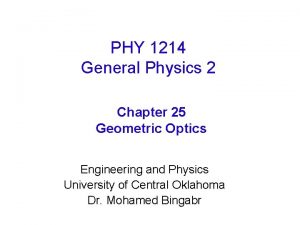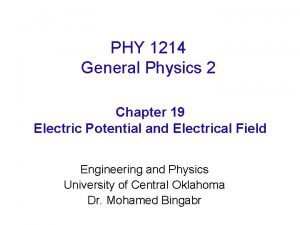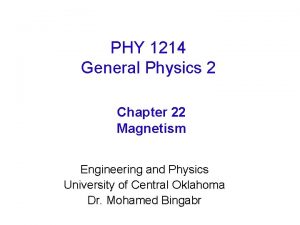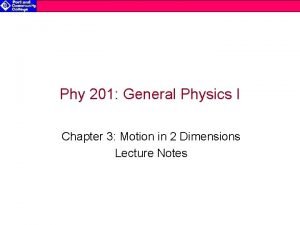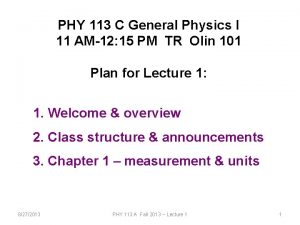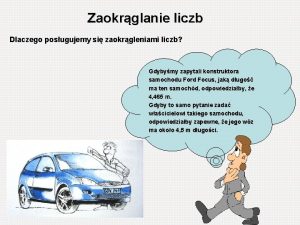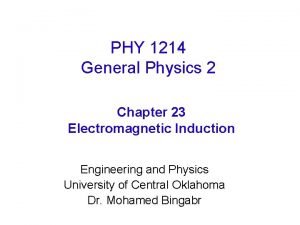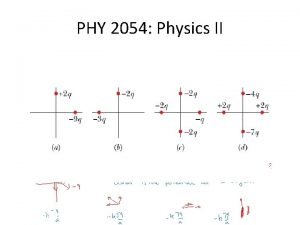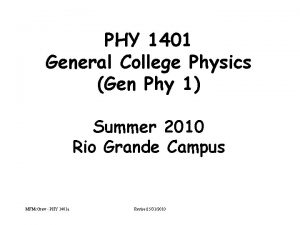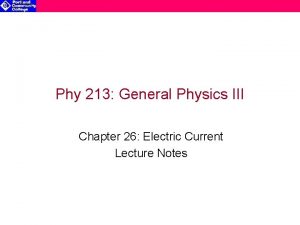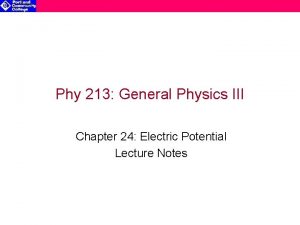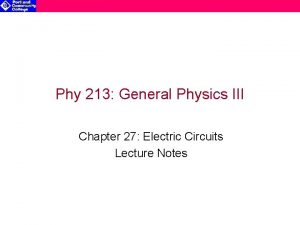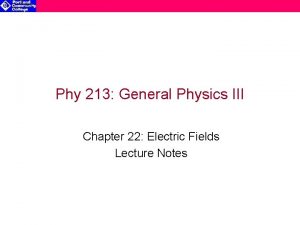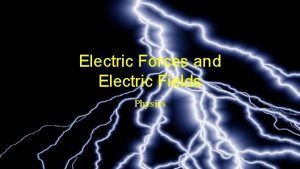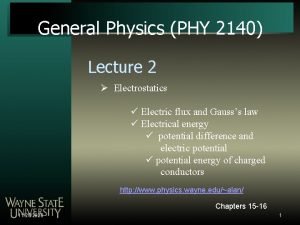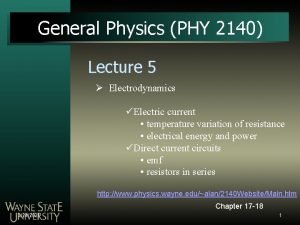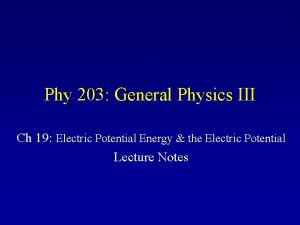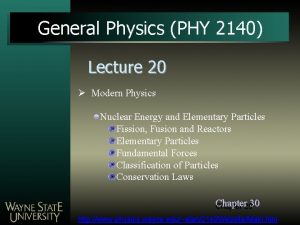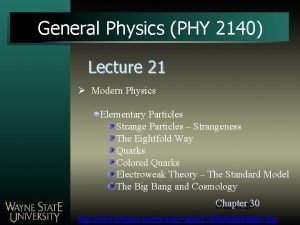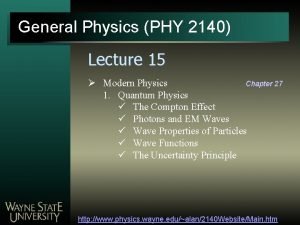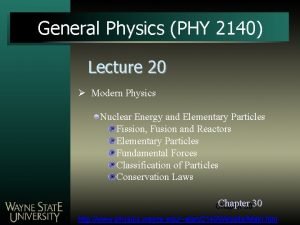PHY 1214 General Physics 2 Chapter 19 Electric


















- Slides: 18

PHY 1214 General Physics 2 Chapter 19 Electric Potential and Electrical Field Engineering and Physics University of Central Oklahoma Dr. Mohamed Bingabr

Chapter Outline • Electric Potential Energy: Potential Difference • Electric Potential in a Uniform Electric Field • Electric Potential due to a Point Charge • Equipotential Lines • Capacitors and Dielectrics • Capacitors in Series and Parallel • Energy Stored in Capacitor

Electric Potential Energy: Potential Difference It takes work to move a charge against an electric field. Just as with gravity, this work increases the potential energy of the charge. U = PE

Electric Potential Energy: Potential Difference Just as with the electric field, it is convenient to define a quantity that is the electric potential energy per unit charge. This is called the electric potential. Unit of electric potential: the volt, V

Electric Potential Energy: Potential Difference The potential difference between parallel plates can be calculated relatively easily: For a pair of oppositely charged parallel plates, the positively charged plate is at a higher electric potential than the negatively charged one by an amount ΔV.

Electric Potential Energy: Potential Difference Ex 19. 1 : A 12 V motorcycle battery can move 5000 C of charge and a 12 V car battery can move 60, 000 C of charge. How much energy does each deliver? A battery moves negative charge from its negative terminal through a headlight to its positive terminal. Appropriate combinations of chemicals in the battery separate charges so that the negative terminal has an excess of negative charge, which is repelled by it and attracted to the excess positive charge on the other terminal. In terms of potential, the positive terminal is at a higher voltage than the negative. Inside the battery, both positive and negative charges move.

Electron Volt One electron volt is the energy given to one electron to accelerate through a potential difference of 1 V. Ex: 5 e. V of energy is required to break certain organic molecule. Ex 19. 3 Conservation of Energy: Calculate the final speed of a free electron accelerated from rest through a potential difference of 100 V. Note: Mass of electron is 9. 11 x 10 -31 Kg KEi + PEi= KEf + PEf

Electric Potential in a Uniform Electric Field Ex 19. 4: Dry air will support a maximum electric field strength of about 3 million V/m. Above that value, the field creates enough ionization in the air to make the air a conductor. This allows a discharge or a spark that reduces the field. What is the maximum voltage between two parallels conducting plates separated by 2. 5 cm of dry air?

Electric Potential Due to a Point Charge The voltage at a distance r from a charge with respect to a point far away from the charge is Ex 19. 6: What is the voltage 5 cm away from the center of 1 cm diameter metal sphere that has -3 n. C static charge.

Electric Potential Due to a Point Charge Ex: Find the voltage at points A and B.

Equipotential Lines The potential is the same along each equipotential line, meaning that no work is required to move a charge anywhere along one of those lines.

Capacitor and Dielectrics • A capacitor is a device used to store electric charge. • The amount of charge Q a capacitor can store depends on two factors: (1) the voltage applied and (2) the capacitors physical characteristics such as size. C : Capacitance Unit: Farad (F)

Capacitor and Dielectrics • Dielectric between the plates increase the capacitance and the amount of charge that can be stored for the same voltage. (a) The molecules in the insulating material between the plates of a capacitor are polarized by the charged plates. This produces a layer of opposite charge on the surface of the dielectric that attracts more charge onto the plate, increasing its capacitance. (b) The dielectric reduces the electric field strength inside the capacitor, resulting in a smaller voltage between the plates for the same charge. The capacitor stores the same charge for a smaller voltage, implying that it has a larger capacitance because of the dielectric.

Capacitor and Dielectrics Ex 19. 8: What is the capacitance of a parallel plate capacitor with metal plates, each of area 1. 00 m 2, separated by 1. 00 mm? What charge is stored in this capacitor if a voltage of 3. 00 103 V applied to it?

Capacitors in Series Total Capacitance in Series Cs Ex: if C 1 = 2 μF, C 2= 4 μF, C 3= 6 μF, and V= 12 V, Find Q, V 1, V 2, V 3.

Capacitors in Parallel Total Capacitance in Parallel Cp (a) Capacitors in parallel. Each is connected directly to the voltage source just as if it were all alone, and so the total capacitance in parallel is just the sum of the individual capacitances. (b) The equivalent capacitor has a larger plate area and can therefore hold more charge than the individual capacitors. (c) The voltage across each capacitor is the same as the voltage of the source. Ex: if C 1 = 2 μF, C 2= 4 μF, C 3= 6 μF, and V= 12 V, Find Q, Q 1, Q 2, Q 3.

Capacitors in Series and Parallel Ex 19. 9: Find the total capacitance of the combination of capacitors shown in Figure (a). C 1 = 1. 000 μF, C 2 = 3. 000 μF, and C 3 = 8. 000 μF.

Energy Stored in Capacitors Ex 19. 11: A heart defibrillator delivers 4. 00 102 J of energy by discharging a capacitor initially at 1. 00 104 V. What is its capacitance?
 General physics
General physics Phy 1214
Phy 1214 General physics
General physics General physics 1 measurements
General physics 1 measurements Vx=vox+axt
Vx=vox+axt Phy 1214
Phy 1214 Chapter 21 electric charge and electric field
Chapter 21 electric charge and electric field Chapter 21 electric charge and electric field
Chapter 21 electric charge and electric field Units of charge
Units of charge Dc o/d per item charge
Dc o/d per item charge Zaokrąglanie do setek
Zaokrąglanie do setek Battaglia di bouvines
Battaglia di bouvines 1214 no tenemos a los cobardes
1214 no tenemos a los cobardes Year 1214
Year 1214 Conceptual physics chapter 35 electric circuits
Conceptual physics chapter 35 electric circuits Conceptual physics chapter 23 electric current
Conceptual physics chapter 23 electric current Phy 131 past papers
Phy 131 past papers Phy 231 msu
Phy 231 msu The great orthogonality theorem
The great orthogonality theorem
